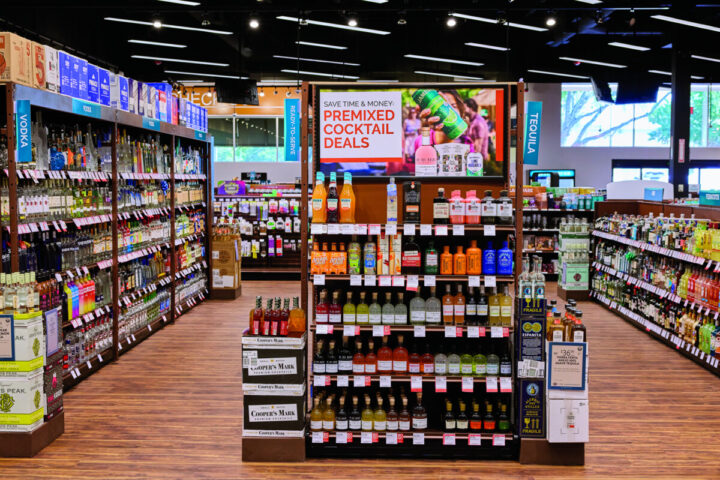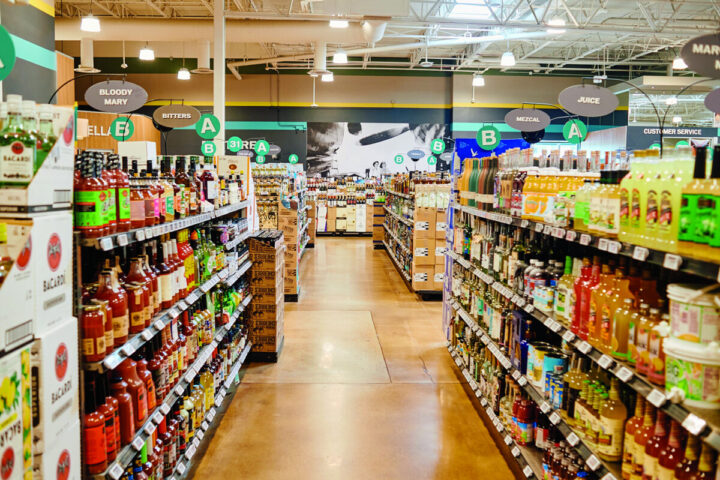
The ready-to-serve (RTS) cocktail space has expanded significantly in recent years as consumers seek out user-friendly drinking experiences. Often confused with the ready-to-drink (RTD) category, which refers to pre-mixed drinks made to be consumed straight from their packaging, ready-to-serve offerings are premium, pre-mixed cocktails that require an extra step or two, such as pouring over ice or serving in a glass. While some brands, like Jose Cuervo and 1800, have been in the RTS space for years, others have more recently debuted labels within the last five years, looking to enjoy some of the growth the Covid-19 lockdowns brought to the category. Today, there is no shortage of RTS options at retail. But as the market’s volume base becomes bigger, the percentage rates of growth have faced some steep headwinds.
The top 20 leading RTS brands have grown 11.3% since 2019, hitting a peak of 5.7 million 9-liter cases in 2023, according to Impact Databank. But depletions softened in 2024, falling 4.6% to 5.5 million cases, with several of those leading brands experiencing double digit declines. Proximo Spirits’ Jose Cuervo Margaritas, the No. 1 ready-to-serve brand in the U.S., took a hit last year, falling 11.5% to just under 2.3 million cases. This marks the second consecutive year of decline for the brand after it fell 6.5% to about 2.5 million cases in 2023.
“We face an industry landscape shaped by evolving market conditions,” Proximo told Market Watch sister publication Shanken News Daily earlier this year. “Following 2024’s industry contraction, our primary goal is to stabilize and build on last year’s market share gains. We will focus on aligning shipments with depletions, sustaining premiumization efforts, and strengthening operational resilience. While we expect growth to be modest, we’re committed to optimizing our performance.”
Another ready-to-serve Margarita brand from Proximo, 1800 Ultimate Margaritas, experienced even harsher declines in 2024, dropping 17% to 860,000 cases, dipping below the 1-million-case mark for the first time since 2020. And according to Lock Reddic, owner of Green’s Discount Beverages in Georgia and South Carolina, the lack of interest in the brand is being noticed at retail. “The best-selling ready-to-serve brand at our stores has always been 1800. On The Rocks is a solid No. 2,” he says. “Both got really big during Covid—since then, 1800 has tanked with the onset of RTD cans, especially now that the category leaders have Tequila-based offerings. The 1800 ready-to-serve line is off about 50% since its peak two years ago. A new price structure has been offered that reduces the retail price by $2-$3 per bottle, so we’ll see if it helps or not.” At Green’s Discount Beverage store, 1800 Ultimate Margaritas retail at $20 a 1.75-liter bottle.
As for On The Rocks, the No. 4 RTS brand in the U.S., the story is a bit different. The brand has enjoyed uninterrupted growth since being acquired by Suntory Global Spirits in 2020. And while growth in 2024 was not quite as strong as it’s been in recent years, On The Rocks still experienced a 7.3% gain to 793,000 cases. “We recognize that today’s consumer is looking for convenience that also delivers on quality. The appeal of ready-to-serve is bar-quality cocktails at home or on-the-go, without the need for mixology tools and mixing ingredients,” says Carol Robert, managing director of U.S. RTDs at Suntory Global Spirits. “Though RTDs have been on the rise, On The Rocks is not new to this arena. The brand debuted in 2015 and has continued to innovate and excel over the last decade.”
While the best-selling On The Rocks variants are Cosmopolitan, Margarita, and Old Fashioned, the company is constantly innovating based on consumer demand. In fact, according to Robert, On The Rocks’ success can be attributed to the brand’s “consumer-centric” approach. “This is what led us to launch the Lemon Drop Martini—our most requested cocktail ever—as well as bring back the Blue Hawaiian as a permanent offering to meet demand,” she says. “We’ve grown by really hearing what our consumers and the market have to say. This idea of ‘gemba’—spending time out in the real world instead of behind a desk—is another core value of Suntory Global Spirits.”

Flavor Craze
Bacardi’s ready-to-serve lineup took a big hit last year, dropping 28.5% to 200,000 cases. This decline continues a four-year softening streak for the brand, which includes flavors such as Mojito, Bahama Mama, Zombie, Island Punch, and Hurricane, among others. Lisa Pfenning, Americas vice president of Bacardi rum, says, “2024 was a recalibration year for Bacardi’s ready-to-serve portfolio, shaped in part by broader shifts in consumer behavior as many returned to bars, restaurants, and on-premise experiences. This shift impacted off-premise sales across the category, contributing to a temporary decline in RTS volume, as reflected in the 28.5% decrease.” Despite this setback, Pfenning says Barcardi is soldiering on. “We’re currently focused on accelerating growth through standout flavored rum expressions and cocktail-led experiences,” she says. “One standout has been Barcardi Mango Chile, featured in seasonal cocktails such as the Mango Fuego.”
The biggest success story of the ready-to-serve category in 2024 was Biggies Buzzballz by Southern Champion, which jumped a whopping 32% to 830,000 cases in 2024. The 1.5-liter ready-to-serve variant has grown 113.6% in the last five years and shows no signs of slowing. Buzzballz was acquired by Sazerac in 2024, and Biggies Buzzballz was one of three offerings from the brand that earned Impact “Hot Brands” status in the same year.
Buzzballz has done particularly well appealing to the younger generation of legal-drinking-age consumers. Brian Thompson, category director for ABC Fine Wine & Spirits, says both Buzzballz and On The Rocks attract a younger demographic at the Florida-based chain. “We’re seeing sales across generations. The standouts are Buzzballz and On The Rocks, which have done a great job reaching the younger demos including Millennials,” Thompson says. “We have some legacy brands like Jose Cuervo that tend to attract a slightly older demographic.” At Hazel’s Beverage World in Boulder, Colorado, liquor manager Maximilian Girardin says the demographic for ready-to-serve has expanded. “Initially the RTD and RTS segment was mostly shopped by the younger demographic,” he says. “But now that the category is far more established and packed with so many quality offerings, we’re seeing people of all demographics picking up RTS products.”
No matter the demographic, new consumers are being brought into the category every day. “We’ve already seen On The Rocks bring new consumers into the ready-to-serve category from wine and beer,” says Suntory’s Robert. “With our new campaign, new permanent and limited-time flavors, and expansion into cans, we’re looking to accelerate that trend.” Pfenning of Bacardi says the rum brand is also targeting consumers from other categories. “Many of these consumers are interested in spirits but may be intimidated by traditional cocktail making,” she notes. “RTS lowers that barrier to entry, providing an approachable, consistent, and accessible way to explore the world of rum-based cocktails.”

Expanding Reach
Brand-owners have been investing in major marketing campaigns to spread the word about their RTS offerings. Diageo has notably promoted their varied lineup of ready-to-serve cocktails from major brands like Ketel One, Astral, Tanqueray, and Bulleit with its ad campaign, “Top 10 Reasons To Love The Cocktail Collection.” The ad includes a QR code to shop the Cocktail Collection, which debuted in 2023, on their website. “Making cocktails at home, and doing it well, can be challenging for the less experienced bartender,” Nikhil Shah, brand director at Diageo, told Shanken News Daily at the time of the launch. “The Cocktail Collection is here to alleviate those concerns with convenient, bar-quality cocktails from trusted brands.”
As the RTS category relies heavily on occasion-based consumption, Suntory is backing On The Rocks with ad copy that implores consumers to indulge in their products beyond those drinking occasions. “The aim of our latest campaign, ‘Make It a Cocktail,’ is to encourage more cocktail occasions overall. We’ve noticed this unspoken understanding and acceptance that specific situations dictate specific drinks,” says Robert. “We aim to challenge that mindset and give consumers the permission and confidence to elevate any moment by choosing a bartender-created On The Rocks cocktail. This is also why we’ve launched On The Rocks in cans this year nationally, to provide an even more convenient offering for cocktail fans.”
Innovation is essential to the ready-to-serve category. Outside of the most popular cocktails—Margarita, Cosmopolitan, and Old Fashioned—there are some other cocktail innovations that are stepping into the spotlight. “Espresso Martini is having its moment,” notes Green’s Discount Beverage’s Reddic. And at Hazel’s, “the Espresso Martini is by far the top selling RTS expression in every brand that offers it,” according to Girardin. For Suntory, innovation has been a key driver behind On The Rocks’ success in recent years, and Robert says even more innovation will follow in years to come. “We’re continuing to emphasize innovation while also refining our core portfolio,” Robert says. “We know consumers are looking for trends and new flavors, so our aim is to continue to deliver against that while staying true to our quality commitment.”
The ready-to-serve category naturally competes for market share with the ready-to-drink category since products in both are similarly billed as convenient, on-the-go cocktail options for consumers who don’t want to go through the trouble of mixing their own cocktails. Unfortunately for the RTS category, RTDs have a leg up on them when it comes to convenience. “I don’t think that RTS will ever catch up to RTD in any meaningful way,” says Hazel’s Girardin. “The entire segment thrives because of the convenience factor; and it is markedly less convenient to have to shake your cocktail and dirty a glass than it is to just crack a chilled can and get to enjoying your beverage. That being said, I think there will always be a space for the category.”
Thompson of ABC Fine Wine and Spirits agrees with Girardin. “It’s hard to see RTS cocktails becoming as popular as RTDs because of some limitations on occasions,” he explains. “It’s much easier to travel with cans than it is with glass or 1.75-liter bottles. Practically speaking, you can enjoy a can anywhere.” Despite this, Thompson says premiumization could be key to rebounding the category and getting ready-to-serve products into the hands of consumers. “We believe higher price points on certain brands help to further legitimize the category, but the products must be of very good quality with higher-end ingredients,” says Thompson. “When products pass the taste test for quality, sales have shown our guests are willing to spend more money for them.”
“Premiumization is also a key to the future. Consumers are increasingly seeking high-quality, authentic cocktail experiences in convenient formats,” says Robert. “We recognize that today’s consumer is looking for convenience that also delivers on quality. The appeal of ready-to-serve is bar-quality cocktails at home or on-the-go, without the need for mixology tools and mixing ingredients.”
Despite the softening that occurred in 2024, RTS brands are not ready to concede to RTDs, with many insisting that ready-to-serve caters to a different occasions and consumer needs than RTDs do. “Ready-to-serve offerings shine in social settings like parties, celebrations, and holidays—where convenience, consistency, and elevated flavor matter most,” says Pfenning. “The ready-to-serve category has seen impressive momentum over the past five years, and all indicators point to continued expansion. As consumers increasingly seek convenience, quality, and elevated social experiences, RTS cocktails are well positioned to meet those evolving needs.”